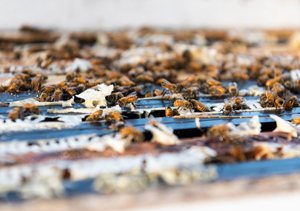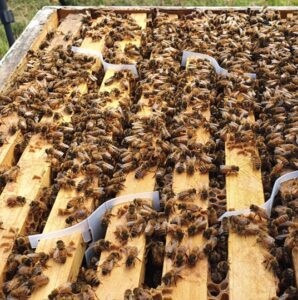What is a Withholding Period?
17 December 2024Guidelines for Beekeepers AHBIC recommends the details listed in our Varroa Chemical Treatment Table are read in conjunction with this article, especially the requirement for each of the current range […]
Guidelines for Beekeepers

AHBIC recommends the details listed in our Varroa Chemical Treatment Table are read in conjunction with this article, especially the requirement for each of the current range of chemicals clearly noting if honey supers are permitted to be on or off while chemicals are being applied to the hive.
A withholding period is the minimum length of time that must elapse between the last application of a varroa treatment and the harvest, sale or use of honey or wax from a hive to which the chemical was applied. Withholding periods (WHPs) are used to ensure compliance with domestic maximum residue limits (MRLs).
These maximum residue limits are set in Australia and overseas markets to ensure that our agricultural products are safe to eat. It is extremely important to ensure withholding periods are adhered to when treating honeybee hives for varroa .
A withholding period, in relation to the use of a permitted or registered product, means the minimum period that needs to pass between:
(a) the last use of the chemical product before a super can be placed on for a honey crop or other product of the hive AND
(b) the physical harvesting of the honey crop or hive product for human consumption.
Adhering to the product labels including the listed withholding periods will ensure that the MRL will not be exceeded.
Withholding periods are based on how quickly any residues breakdown. Always make sure you follow the permit then the label, use the recommended dose (for hive size) and the recommended dose frequency. Overdosing can lead to excess residues. This can endanger human health and the reputation of Australia’s beekeeping businesses, products and domestic and export markets.

In general –
- stick to the permit followed by the label (this is APVMA approved, and the withholding periods depend on correct dosing),
- don’t repeat a dose sooner than the permit or label allows (i.e. within the ‘re-treatment interval’ – if the product has not achieved satisfactory efficacy, consult with a Varroa Development Officer (from the T2M Program if before February 2026) and your local state department of agriculture apiary team.
- ensure you rotate chemical classes so that you don’t inadvertently ‘double-up’ on an active ingredient, by checking the mode of action and chemical name of what’s in a product.
Check withholding periods before using products
It’s important to note that not all treatments are the same, including when it comes to withholding periods. Products with the same mode of action and chemical class may have differences to withholding periods which beekeepers must be aware of and adhere to.
Checking the WHP and understanding the requirements considering the colony phase and the purpose of your beekeeping can be a game changer when it comes to treating for varroa.
For example:
- Some treatments state you must not have supers on hives when using the product, i.e. Apivar, Apitraz, Apiguard AND Apistan.
- Some treatments can be used when supers are on hives, but have a withholding period and these can vary in length so should be fully understood by the beekeeper, i.e. Formic Pro
- Some products prevent the sale or harvesting of honey comb for human consumption due to the treatments being absorbed into wax products, i.e. Bayvarol (Flumethrin).
